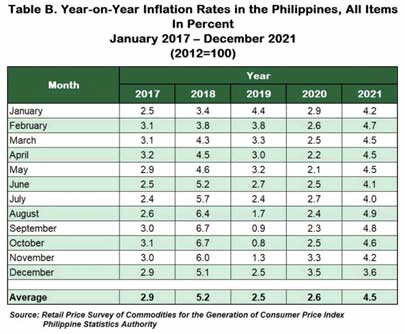
The country’s headline inflation or consumer price slowed down further to 3.6 percent in December 2021, from 4.2 percent in November 2021.
This is the lowest inflation posted for the year 2021.
The average inflation at the national level for the year 2021 at 4.5 percent was higher relative to the average inflation in 2020 at 2.6 percent. It is also higher than the government’s target range of 2% to 4%.
The latest annual print is also the highest in three years since the 5.2% in 2018.
The main source of the downward trend of the December 2021 overall inflation was primarily brought about by the slower annual increase in food and non-alcoholic beverages at 3.1 percent in December 2021, from 3.9 percent in November 2021.
Lower inflation recorded in the indices of the following commodity groups also contributed to the downward trend in the overall inflation during the month:
- Alcoholic beverages and tobacco, 6.5 percent;
- Clothing and footwear, 1.8 percent;
- Furnishing, household equipment and routine maintenance of the house, 2.3 percent;
- Health, 3.0 percent;
- Transport, 6.1 percent;
- Recreation and culture, 0.9 percent; and
- Restaurant and miscellaneous goods and services, 3.5 percent.
On the contrary, inflation rates were higher in the indices of housing, water, electricity, gas and other fuels at 5.0 percent, and communication at 0.3 percent.
For three consecutive months now, inflation for education index was posted at 0.7 percent.
Annual average inflation rates in 2021 were higher in the following major commodity groups relative to their annual average inflation in 2020:
- Food and non-alcoholic beverages, 5.2 percent;
- Housing, water, electricity, gas, and other fuels, 2.6 percent;
- Health, 3.0 percent;
- Transport, 9.7 percent; and
- Restaurant and miscellaneous goods and services, 3.6 percent.
On the other hand, other commodity groups exhibited slower annual average inflation or negative annual average rate during the year, except for communication which retained its 2020 annual average rate of 0.3 percent.
Core inflation, which excludes selected food and energy items, also slowed down further to 3.0 percent in December 2021, from 3.3 percent in November 2021.
In December 2020, core inflation was observed at 3.3 percent.
The annual average core inflation in 2021 was recorded at 3.3 percent, slightly higher than its 3.2 percent annual average rate in 2020.
Inflation for food at the national level continued to move downward as it decelerated further to 3.2 percent during the month, from 4.1 percent in November 2021.
In December 2020, inflation for food was posted at 4.9 percent.
By food group, the annual growth rate of the vegetables index decreased further by -10.0 percent in December 2021.
Moreover, annual increases were slower in the indices of rice at 0.9 percent; corn, 14.4 percent; fish, 7.0 percent; and milk, cheese, and eggs at 1.1 percent. The indices of other food groups registered higher annual increments during the month.
National Capital Region
Inflation in NCR, similarly, moved up at a slower pace of 2.8 percent in December 2021, from 2.9 percent in November 2021. Inflation in the region in December 2020 was observed at 3.2 percent.
The annual average inflation in NCR for the year 2021 was higher at 3.5 percent, from 2.2 percent in 2020.
The deceleration in the inflation in NCR was primarily due to the lower annual rate of increment in transport index at 5.6 percent during the month, from 7.6 percent in November 2021. Annual upticks also slowed down in the indices of food and non-alcoholic beverages at 1.5 percent; alcoholic beverages and tobacco, 6.6 percent; and furnishing, household equipment and routine maintenance of the house at 1.0 percent.
Meanwhile, annual increases were higher in the indices of housing, water electricity, gas and other fuels at 4.4 percent, and restaurant and miscellaneous goods and services at 2.9 percent. The rest of the commodity groups retained their previous month’s annual rates or had zero percent annual growth during the month.
Areas Outside NCR
Inflation in AONCR also eased further to 3.9 percent in December 2021, from 4.5 percent in November 2021. In December 2020, inflation in AONCR was observed at 3.7 percent.
The annual average inflation in AONCR accelerated to 4.7 percent in 2021, from 2.7 percent in 2020.
The downtrend in the inflation of AONCR was primarily due to the slower annual rate of increase in food and non-alcoholic beverages index at 3.5 percent during the month. Likewise, annual hikes decelerated in the indices of the following commodity groups:
- Alcoholic beverages and tobacco, 6.4 percent;
- Clothing and footwear, 2.0 percent;
- Furnishing, household equipment and routine maintenance of the house, 2.7 percent;
- Health, 2.8 percent;
- Transport, 6.3 percent;
- Recreation and culture, 1.1 percent; and
- Restaurant and miscellaneous goods and services, 3.6 percent.
On the other hand, inflation for housing, water, electricity, gas, and other fuels was higher at 5.2 percent, while the indices of the rest of the commodity groups retained their previous month’s annual growth rates.
Compared with their annual growth rates in November 2021, 13 regions in AONCR exhibited lower inflation during the month. The Bangsamoro Autonomous Region in Muslim Mindanao (BARMM) still recorded the lowest inflation at 2.1 percent, while Region IX (Zamboanga Peninsula) and Region XI (Davao Region) both exhibited the highest inflation at 6.1 percent.
Relative to their 2020 annual average rates, all regions in AONCR had higher annual average inflation in 2021. Region V (Bicol Region) posted the highest annual average inflation during the year at 6.6 percent.
On the other hand, Region VII (Central Visayas) had the lowest annual average inflation of 2.5 percent.
WITHIN BSP ESTIMATES
Meanwhile, the Bangko Sentral ng Pilipinas (BSP) said the December 2021 inflation of 3.6 percent was within its forecast range of 3.5 to 4.3 percent.
Inflation is projected to ease close to the midpoint of the target range in 2022 and 2023.
“The supply disruptions and agricultural damages from typhoon Odette will likely result in a temporary uptick in the prices of food items and other necessities over the near term. As with previous episodes of natural disasters, the effective implementation of non-monetary government intervention measures to ensure adequate domestic food supply must be sustained in order to mitigate potential supply-side pressures on inflation,” BSP said in a statement.
The BSP said it will incorporate the typhoon’s impact into its projections once firm estimates become available.
At the same time, the implementation of reconstruction efforts and rehabilitation programs in areas damaged by the storm will be essential to support economic recovery and prevent job losses.






















